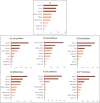Spatio-temporal dynamics and risk cluster analysis of highly pathogenic avian influenza (H5N1) in poultry: Advancing outbreak management through customized regional strategies in Egypt
- PMID: 39737019
- PMCID: PMC11682780
- DOI: 10.5455/OVJ.2024.v14.i11.20
Spatio-temporal dynamics and risk cluster analysis of highly pathogenic avian influenza (H5N1) in poultry: Advancing outbreak management through customized regional strategies in Egypt
Abstract
Background: Highly pathogenic avian influenza (HPAI) (H5N1) has been endemic in Egypt for almost two decades, profoundly impacting both the poultry industry and public health. Egypt stands as a prominent epicenter for HPAI H5N1 outbreaks in Africa, marked by the highest number of positive human cases. Despite continuous governmental efforts, prior research underscored the inadequacy of strategies in controlling the virus spread.
Aim: This study identified spatiotemporal patterns and high-risk clusters of HPAI H5N1 outbreaks at the subdistrict level.
Methods: This study involved trial tracking of HPAI H5N1 endemicity dynamics, enabling tailored interventions at a regional level based on robust epidemiological investigations to address the persistent challenge of HPAI H5N1 in Egypt. This study illuminated spatiotemporal outbreak dynamics, with specific attention on Menofia governorate.
Results: Despite the region's early poultry impacts, initial outbreaks did not originate from Menofia in studied epidemic waves (EWs). Outbreak risk spatial distribution displayed an escalating pattern at the northern border, followed by risk reduction through the sixth EW. The predominant hot spot region was localized within rural districts, particularly villages, while urbanization coincided with lower outbreak density. Observed smoothed densities revealed epidemic propagation within urban centers, preceding its transition to new areas and establishing direct connections with neighboring cities. Primary cluster prognostication was plausible, occurring in regions previously hosting elevated relative risk clusters during preceding EWs. Identification of enduring pinpoint clusters, persistent for extended durations, indicated close contact dynamics and localized viral circulation within populations.
Conclusion: This study highlights the significance of customized regional interventions based on the rigorous epidemiological framework. This approach is pivotal in the profound comprehension of endemicity dynamics, efficiently limits geographical infection spread, and contains outbreaks within delineated areas.
Keywords: Endemicity dynamics; Highly pathogenic avian influenza; Risk clusters; Spatiotemporal dynamics; Tailored intervention strategies.
Conflict of interest statement
The authors declare that they have no competing interests.
Figures





Similar articles
-
Spatiotemporal analysis of highly pathogenic avian influenza (H5N1) outbreaks in poultry in Egypt (2006 to 2017).BMC Vet Res. 2022 May 12;18(1):174. doi: 10.1186/s12917-022-03273-w. BMC Vet Res. 2022. PMID: 35550145 Free PMC article.
-
A quantitative risk assessment to evaluate the efficacy of mitigation strategies to reduce highly pathogenic avian influenza virus, subtype H5N1 (HPAI H5N1) in the Menoufia governorate, Egypt.BMC Vet Res. 2021 Jun 7;17(1):210. doi: 10.1186/s12917-021-02917-7. BMC Vet Res. 2021. PMID: 34098961 Free PMC article.
-
Avian influenza A (H5N1) outbreaks in different poultry farm types in Egypt: the effect of vaccination, closing status and farm size.BMC Vet Res. 2018 Jun 18;14(1):187. doi: 10.1186/s12917-018-1519-8. BMC Vet Res. 2018. PMID: 29914481 Free PMC article.
-
An overview of the epidemic of highly pathogenic H5N1 avian influenza virus in Egypt: epidemiology and control challenges.Epidemiol Infect. 2011 May;139(5):647-57. doi: 10.1017/S0950268810003122. Epub 2011 Feb 1. Epidemiol Infect. 2011. PMID: 21281550 Review.
-
Highly pathogenic avian influenza H5N1, Thailand, 2004.Emerg Infect Dis. 2005 Nov;11(11):1664-72. doi: 10.3201/eid1111.050608. Emerg Infect Dis. 2005. PMID: 16318716 Free PMC article. Review.
Cited by
-
Investigating the role of environmental factors in the French highly pathogenic avian influenza epizootic in 2022-2023.Front Vet Sci. 2025 Jun 13;12:1541019. doi: 10.3389/fvets.2025.1541019. eCollection 2025. Front Vet Sci. 2025. PMID: 40586036 Free PMC article.
References
-
- Abdelwhab, E.M. and Hafez, H.M. 2011. An overview of the epidemic of highly pathogenic H5N1 avian influenza virus in Egypt: epidemiology and control challenges. Epidemiol. Infect. 139(5), 647–657. - PubMed
-
- Abdelwhab, E., Hassan, M., Abdel-Moneim, A., Naguib, M., Mostafa, A., Hussein, I., Arafa, A., Erfan, A., Kilany, W. and Agour, M. 2016. Introduction and enzootic of A/H5N1 in Egypt: virus evolution, pathogenicity and vaccine efficacy ten years on. Infect. Genet. Evol. 40, 80–90. - PubMed
-
- Ali, A., Ankers, P., DeHaan, N., Saad, A., Hussein, S., Lubroth, J. and Jobre, Y. 2013. Mapping influenza A (H5N1) virus transmission pathways and critical control points in Egypt. FAO Anim. Prod. Health. Work.
-
- Aly, M., Arafa, A. and Hassan, M. 2008. Epidemiological findings of outbreaks of disease caused by highly pathogenic H5N1 avian influenza virus in poultry in Egypt during 2006. Avian Dis. 52(2), 269–277. - PubMed
-
- Arafa, A., Suarez, D., Kholosy, S., Hassan, M., Nasef, S., Selim, A., Dauphin, G., Kim, M., Yilma, J. and Swayne, D. 2012. Evolution of highly pathogenic avian influenza H5N1 viruses in Egypt indicating progressive adaptation. Arch. Virol. 157(10), 1931–1947. - PubMed
MeSH terms
LinkOut - more resources
Full Text Sources
Medical
